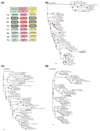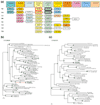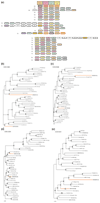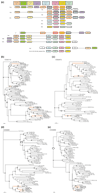Evolution of mosaic operons by horizontal gene transfer and gene displacement in situ - PubMed (original) (raw)
Evolution of mosaic operons by horizontal gene transfer and gene displacement in situ
Marina V Omelchenko et al. Genome Biol. 2003.
Abstract
Background: Shuffling and disruption of operons and horizontal gene transfer are major contributions to the new, dynamic view of prokaryotic evolution. Under the 'selfish operon' hypothesis, operons are viewed as mobile genetic entities that are constantly disseminated via horizontal gene transfer, although their retention could be favored by the advantage of coregulation of functionally linked genes. Here we apply comparative genomics and phylogenetic analysis to examine horizontal transfer of entire operons versus displacement of individual genes within operons by horizontally acquired orthologs and independent assembly of the same or similar operons from genes with different phylogenetic affinities.
Results: Since a substantial number of operons have been identified experimentally in only a few model bacteria, evolutionarily conserved gene strings were analyzed as surrogates of operons. The phylogenetic affinities within these predicted operons were assessed first by sequence similarity analysis and then by phylogenetic analysis, including statistical tests of tree topology. Numerous cases of apparent horizontal transfer of entire operons were detected. However, it was shown that apparent horizontal transfer of individual genes or arrays of genes within operons is not uncommon either and results in xenologous gene displacement in situ, that is, displacement of an ancestral gene by a horizontally transferred ortholog from a taxonomically distant organism without change of the local gene organization. On rarer occasions, operons might have evolved via independent assembly, in part from horizontally acquired genes.
Conclusions: The discovery of in situ gene displacement shows that combination of rampant horizontal gene transfer with selection for preservation of operon structure provides for events in prokaryotic evolution that, a priori, seem improbable. These findings also emphasize that not all aspects of operon evolution are selfish, with operon integrity maintained by purifying selection at the organism level.
Figures
Figure 1
Genes with different phylogenetic affinities in a ribosomal operon from Aquifex aeolicus and Rickettsia prowazekii. (a) A fragment of ribosomal operon in Aquifex aeolicus (the operon from Thermotoga maritima is shown for comparison), Rickettsia prowazekii and Rickettsia conorrii (operons from other alpha-proteobacteria are shown for comparison). Genes are shown not to scale; the direction of transcription is indicated by arrows and gene numbers/names are given inside each arrow. Orthologous genes are shown by the same color. White arrows show genes in each genome that are unique in this operonic context. Phylogenetic affinity of a gene is shown as a thick colored border on the respective arrow; black denotes belonging to the reference taxon, red denotes not belonging to reference taxon. COG0197 - ribosomal protein L16/L10E; COG0255 - ribosomal protein L29; COG0186 - ribosomal protein S17. For species abbreviations, see Materials and methods. (b) Unrooted maximum-likelihood tree for ribosomal protein L16. Branches supported by bootstrap probability >70% are marked by black circles. Names of the genes from mosaic operons and the respective branches are shown in red. Branches for which the likelihoods of alternative placements were assessed using the RELL method are indicated by circles with numbers (see Table 3). (c) Unrooted maximum-likelihood tree for ribosomal protein L29;. the designations are as in Figure 1b. (d) Unrooted maximum-likelihood tree for ribosomal protein S17; the designations are as in Figure 1b.
Figure 2
In situ displacement of the ruvB gene in Mycoplasma. (a) Organization of the Holliday junction resolvasome operon and surrounding genes in bacteria. COG0632 - Holliday junction resolvasome, DNA-binding subunit, COG2255 - Holliday junction resolvasome, DNA-binding subunit, COG0817 - Holliday junction resolvasome, endonuclease subunit, COG0392 - Predicted integral membrane protein, COG0282 - acetate kinase, COG0839 - NADH:ubiquinone oxidoreductase subunit 6 (chain J), COG0244 - ribosomal protein L10, COG0732 - restriction endonuclease S subunits, COG0809 - S-adenosylmethionine:tRNA-ribosyltransferase-isomerase, COG0772 - bacterial cell division membrane protein, COG0624 - acetylornithine deacetylase/succinyl-diaminopimelate desuccinylase and related deacylases, COG1487 - predicted nucleic acid-binding protein, COG1132 - ABC-type multidrug transport system, ATPase and permease components, COG0442 - prolyl-tRNA synthetase, COG0323 - DNA mismatch repair enzyme, COG1408 - predicted phosphohydrolases. The designations are as in Figure 1a. For species abbreviations, see Materials and methods. (b,c) Unrooted maximum-likelihood tree for RuvA (b) and RuvB (c); the designations are as in Figure 1b.
Figure 3
Genes with different phylogenetic affinities in the lipid biosynthesis operon of Rickettsia. (a) Organization of the lipid biosynthesis operon and surrounding genes in Rickettsia prowazekii and Rickettsia conorrii (operons from three other alpha-proteobacteria are shown for comparison). COG0020 - undecaprenyl pyrophosphate synthase, UppS; COG0575 - CDP-diglyceride synthetase; COG0750 - predicted membrane-associated Zn-dependent proteases; COG0233 - ribosome recycling factor; COG0528 - uridylate kinase; COG0745 - OmpR-like response regulator; COG0642 - signal transduction histidine kinase; COG0729 - outer membrane protein; COG2919 - septum formation initiator; COG0743 - 1-deoxy-D-xylulose 5-phosphate reductoisomerase. The designations are as in Figure 1a. For species abbreviations, see Materials and methods. (b,c) Unrooted maximum-likelihood tree for UppS (b) and CdsA (c); the designations are as in Figure 1b.
Figure 4
In situ gene displacement in the NADH-ubiquinone oxidoreductase operon in Halobacterium. (a) Organization of the NADH-ubiquinone oxidoreductase operon in selected archaeal and bacterial genomes. COG0838 - NADH:ubiquinone oxidoreductase subunit 3 (chain A), COG3077 - DNA-damage-inducible protein J, COG0852 - NADH:ubiquinone oxidoreductase 27 kD subunit, COG0649 - NADH:ubiquinone oxidoreductase 49 kD subunit 7, COG1905 - NADH:ubiquinone oxidoreductase 24 kD subunit, COG1894 - NADH:ubiquinone oxidoreductase, NADH-binding (51 kD) subunit, COG1034 - NADH dehydrogenase/NADH:ubiquinone oxidoreductase 75 kD subunit (chain G), COG1005 - NADH:ubiquinone oxidoreductase subunit 1 (chain H), COG1143 - Formate hydrogenlyase subunit 6/NADH:ubiquinone oxidoreductase 23 kD subunit (chain I), COG0839 - NADH:ubiquinone oxidoreductase subunit 6 (chain J), COG0713 - NADH:ubiquinone oxidoreductase subunit 11 or 4L (chain K), COG1009 - NADH:ubiquinone oxidoreductase subunit 5 (chain L), COG1008 - NADH:ubiquinone oxidoreductase subunit 4 (chain M), COG1007 - NADH:ubiquinone oxidoreductase subunit 2 (chain N). The designations are as in Figure 1a. For species abbreviations, see Materials and methods. (b-d) Unrooted maximum-likelihood tree for NuoH (b), NuoI (c) and NuoJ (d); the designations are as in Figure 1b.
Figure 5
Genes with different phylogenetic affinities in the lipopolysaccharide biosynthesis operon of Methanothermobacter thermoautotrophicus and Deinococcus radiodurans. (a) Organization of the lipopolysaccharide biosynthesis operon in different prokaryotes. COG1091 - dTDP-4-dehydrorhamnose reductase; COG1209 dTDP-glucose pyrophosphorylase; COG1898 - dTDP-4-dehydrorhamnose 3,5-epimerase and related enzymes; COG1088 - dTDP-D-glucose 4,6-dehydratase. The designations are as in Figure 1a. For species abbreviations, see Materials and methods. (b-e) Unrooted maximum-likelihood tree for RfbB (b), RfbC (c), RfbA (d) and RfbD (e); the designations are as in Figure 1b.
Figure 6
Genes with different phylogenetic affinities in the leucine/isoleucine biosynthesis operon. (a) Operon organization in different prokaryotic species. COG0028 - acetolactate synthase, large subunit; COG0440 - acetolactate synthase, small subunit; COG0059 - ketol-acid reductoisomerase; COG0129 - dihydroxyacid dehydratase; COG0119 - isopropylmalate synthases; COG0473 - isocitrate/isopropylmalate dehydrogenase; COG0066 - 3-isopropylmalate dehydratase, small subunit; COG0065 - 3-isopropylmalate dehydratase, large subunit. The designations are as in Figure 1a. For species abbreviations, see Materials and methods. (b-e) Unrooted maximum-likelihood tree for LeuA (b), LeuB (c), LeuC (d) and LeuD (e); the designations are as in Figure 1b.
Similar articles
- Genome trees constructed using five different approaches suggest new major bacterial clades.
Wolf YI, Rogozin IB, Grishin NV, Tatusov RL, Koonin EV. Wolf YI, et al. BMC Evol Biol. 2001 Oct 20;1:8. doi: 10.1186/1471-2148-1-8. BMC Evol Biol. 2001. PMID: 11734060 Free PMC article. - Organisation of the S10, spc and alpha ribosomal protein gene clusters in prokaryotic genomes.
Coenye T, Vandamme P. Coenye T, et al. FEMS Microbiol Lett. 2005 Jan 1;242(1):117-26. doi: 10.1016/j.femsle.2004.10.050. FEMS Microbiol Lett. 2005. PMID: 15621428 - Inter-genomic displacement via lateral gene transfer of bacterial trp operons in an overall context of vertical genealogy.
Xie G, Bonner CA, Song J, Keyhani NO, Jensen RA. Xie G, et al. BMC Biol. 2004 Jun 23;2:15. doi: 10.1186/1741-7007-2-15. BMC Biol. 2004. PMID: 15214963 Free PMC article. - Genomics of bacteria and archaea: the emerging dynamic view of the prokaryotic world.
Koonin EV, Wolf YI. Koonin EV, et al. Nucleic Acids Res. 2008 Dec;36(21):6688-719. doi: 10.1093/nar/gkn668. Epub 2008 Oct 23. Nucleic Acids Res. 2008. PMID: 18948295 Free PMC article. Review. - Evidence against the selfish operon theory.
Pál C, Hurst LD. Pál C, et al. Trends Genet. 2004 Jun;20(6):232-4. doi: 10.1016/j.tig.2004.04.001. Trends Genet. 2004. PMID: 15145575 Review.
Cited by
- Evolution End Classification of tfd Gene Clusters Mediating Bacterial Degradation of 2,4-Dichlorophenoxyacetic Acid (2,4-D).
Iasakov T. Iasakov T. Int J Mol Sci. 2023 Sep 21;24(18):14370. doi: 10.3390/ijms241814370. Int J Mol Sci. 2023. PMID: 37762674 Free PMC article. - The Operon as a Conundrum of Gene Dynamics and Biochemical Constraints: What We Have Learned from Histidine Biosynthesis.
Del Duca S, Semenzato G, Esposito A, Liò P, Fani R. Del Duca S, et al. Genes (Basel). 2023 Apr 21;14(4):949. doi: 10.3390/genes14040949. Genes (Basel). 2023. PMID: 37107707 Free PMC article. Review. - A complete theoretical framework for inferring horizontal gene transfers using partial order sets.
Belal NA, Heath LS. Belal NA, et al. PLoS One. 2023 Mar 24;18(3):e0281824. doi: 10.1371/journal.pone.0281824. eCollection 2023. PLoS One. 2023. PMID: 36961781 Free PMC article. - Incompatibility and Interchangeability in Molecular Evolution.
Sloan DB, Warren JM, Williams AM, Kuster SA, Forsythe ES. Sloan DB, et al. Genome Biol Evol. 2023 Jan 4;15(1):evac184. doi: 10.1093/gbe/evac184. Genome Biol Evol. 2023. PMID: 36583227 Free PMC article. Review. - Annotation-free delineation of prokaryotic homology groups.
Yin Y, Ogilvie HA, Nakhleh L. Yin Y, et al. PLoS Comput Biol. 2022 Jun 8;18(6):e1010216. doi: 10.1371/journal.pcbi.1010216. eCollection 2022 Jun. PLoS Comput Biol. 2022. PMID: 35675326 Free PMC article.
References
- Jacob F, Monod J. Genetic regulatory mechanisms in the synthesis of proteins. J Mol Biol. 1961;3:318–356. - PubMed
- Miller JH, Reznikoff WSE. The Operon. Cold Spring Harbor, NY: Cold Spring Harbor Laboratory; 1978.
- Mushegian AR, Koonin EV. Gene order is not conserved in bacterial evolution. Trends Genet. 1996;12:289–290. - PubMed
- Dandekar T, Snel B, Huynen M, Bork P. Conservation of gene order: a fingerprint of proteins that physically interact. Trends Biochem Sci. 1998;23:324–328. - PubMed
- Watanabe H, Mori H, Itoh T, Gojobori T. Genome plasticity as a paradigm of eubacteria evolution. J Mol Evol. 1997;44:S57–S64. - PubMed
Publication types
MeSH terms
Substances
LinkOut - more resources
Full Text Sources





